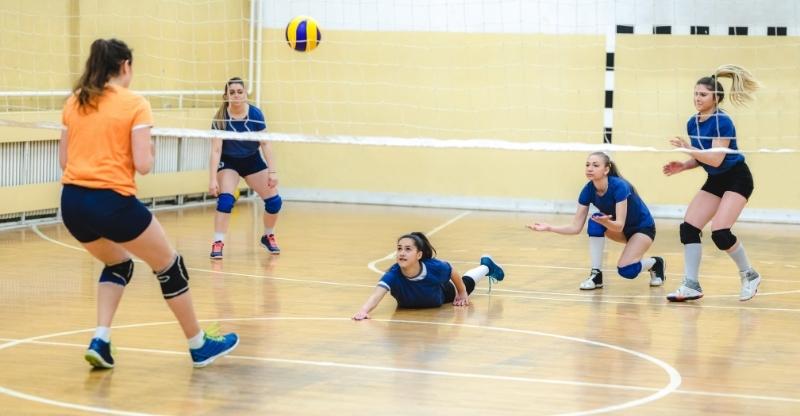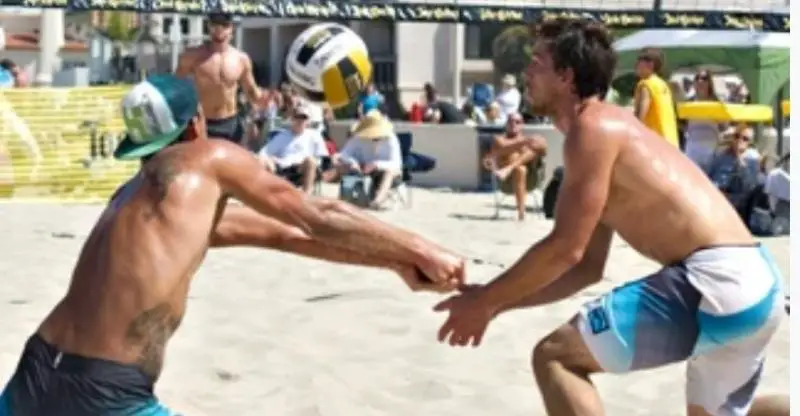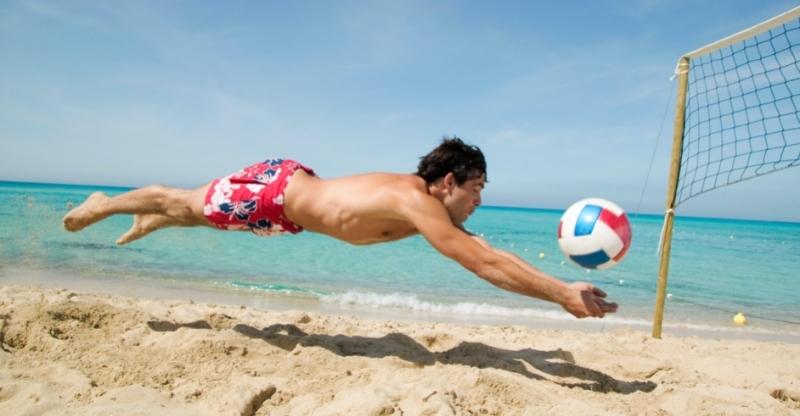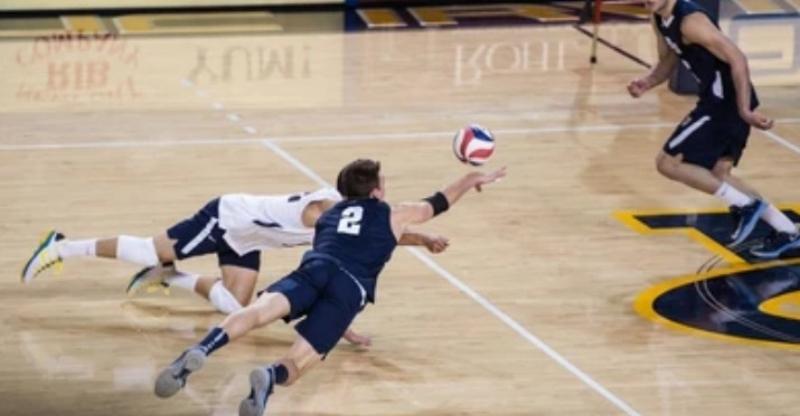Not many people actually know what a dig is in volleyball. Is it the same as a pass? A dive? It seems some people can’t agree.
So, what is a dig in volleyball? A dig in volleyball happens when a player passes a spike from the opposing team. This may involve diving, lunging, or other reactive movements. Digs keep the point alive and offer the defense a chance to spike back.
Not knowing the importance of the dig means that your team will likely lose a point every time you allow the opposing team to score (unless you have an “iron curtain” block: nothing gets by).
For some teams, this is an acceptable loss, choosing to focus on their offensive ability and trusting that they can stay ahead of their opponent. But if you fall behind, chances of victory can start to look bleak.
Digging is more than passing: it’s putting yourself deliberately in the path of the most powerful attacks in the game. That takes courage, and it should be no surprise that many players struggle with this. But with good mentality and self-confidence, you can start training yourself to turn your passing ability to your team’s advantage.
In this article, I’ll be discussing:
- How to make an effective dig
- Top mistakes when digging
- Drills to make you a more effective digger
Who Makes A Dig In Volleyball?
Before we begin, let’s acknowledge something: spikes are scary. It makes sense – a strong athlete with killer intention slamming the ball down as hard as they can? Yeah, that’ll do it.
And yet, you have to stop it hitting the floor.
Digging isn’t easy, but it’s necessary to be the best. Every player on the team should be able to dig, no matter their position, but the primary duty falls to the libero. As a defensive specialist, the libero’s entire job revolves around picking up those hard-to-get balls and spikes, meaning that they should be trying for every dig possible.
However, while the libero’s zone of influence takes up most of the back court, it is very difficult to control where the spike goes (one way to do this is with blocking tactics, but that will be discussed in another article). As the spike can go anywhere, every player must be ready to dig.
Whether you pass with your arms, legs, feet, or head, at the end of the day the ball must go up.
What Is A Dig?

A dig is another name for a pass in volleyball when a player passes a spike from the opposing team and successfully puts it into play. If the dig fails, putting the ball out of bounds, this is called a “shank” or general fault.
A dig may involve diving, lunging, or other reactive movement, looking somewhat like a digging motion to spectators, from which the action got its name.
In essence, a dig can involve any body part and any movement in order to keep the ball alive, resulting in some truly extraordinary defensive plays. One classic example is digging the ball up off one’s foot!
The point of a dig is to keep the point alive and offer the defense a chance to spike back.
The only way a team on defense can score is if their opponent commits a fault – the higher level you play at though, the less this happens. Digs allow teams to turn defense into offense without dropping a point in-between, giving them control over the match.
Digs can also disrupt the spiking rhythm of opposing spikers, rattling their nerves. After all, if your opponent is easily passing your best attacks, your self-confidence will probably take a hit. This will affect your mentality, leading to less effective actions, resulting in a lower threat to the opposition.
Never forget the power of the mental game in volleyball and its influence on the score. Getting successful digs is one sure way to go on this mental offensive.
How To Make An Effective Dig

Making an effective dig is much the same as our normal passing form, with a few key differences.
These are:
- Power
- Preparation
- Angle
- Positioning
Power
First, let’s discuss power.
Spikes are the most powerful attacks in the game and include a tremendous amount of force.
Even without moving our arms, this force can cause the ball to ricochet wildly and bounce too high, hitting the ceiling or returning to the opposing team. This isn’t ideal, obviously, and only buys time.
The best digs are sometimes performed with absorb passes.
To perform this pass, players bend their knees and lean backwards as they contact the ball, absorbing much of the power and resulting in a much slower, more controlled pass that stays on their side of the court.
The biggest challenge of dealing with a spike’s power is the fear the noise and velocity create in a passer’s mind.
This is mostly connected to a fear of getting hurt, and I’ll cover this problem further in the article.
The only way to deal with this is experience: the more spikes you dig, the easier it will become. Make a habit of effort and excellence will become second nature.
Preparation
When passing normally, we often train by passing to each other in high, looping passes that allow plenty of time to set up.
Even when our teammates or coaches downball to us, we know that the ball is coming our way and can track it through the toss and hit. This gives us the luxury of time.
When digging a spike, this luxury is gone.
Spikes cross the court incredibly fast, not allowing us much time to react at all. Standing up straight or looking at someone in the crowd are both examples of inefficient passing preparation and might make the difference between a good pass and a failed dig.
In order to deal with this and dig properly, we need preparation.
Be in your passing position, weight forward and arms ready, knees slightly bent and ready to move. Watch the set and follow the ball as it leaves the setter’s hands.
There is often a desire to watch the spiker as they hit, but don’t make this mistake: your focus is the ball alone.
Take a stutter step as the spiker contacts the ball – a quick preparation step forward that repositions your weight and starts you moving – and immediately move to dig if it’s within reach.
It’s easier to move when already in motion, and much harder to start from nothing. (This is the concept of inertia: thanks Einstein!)
The more time we have, the better the end result of our passing will be. Proper preparation gives us time to react and raises the probability of a successful dig.
Angle
When we practice passing, it’s normally when we’re directly facing our teammates or coach, but when we dig a spike it’s usually coming at us from an angle, across the court since that’s the easiest spike to hit.
To properly dig, we need to account for this angle and adjust to it.
Think about where your setter is before you set up: this is who you’re passing to, so how will you pass to them? What is the easiest angle?
Remember, the easier you make it for your setter, the easier the rest of your team will have it also.
Think about the position of your blockers too.
There’s no point setting up behind the block – if the spiker hits in that direction, it will just contact their hands and be stopped, after all.
Move so that you can clearly see the ball when the spiker contacts it, as this is where the ball will come. If your blockers have done their job correctly, you should either be covering straight line or cross on the ten foot line.
Adjust as needed, depending on where the spike is coming from.
Middle blockers are unpredictable since they hit from the middle of the court, so a standard triangle defense should be a good enough angle to pick up their spike. Take a step in if you’re feeling confident: middle blockers love to hit straight down.
Find your angle on court quickly – the spiker won’t wait for you.
Angle your body to face the direction of the spike head-on, not the setter, as this will give you the best chance of digging it effectively.
Whether you’re passing from here, diving out of this position, or running to pick up an out of place spike, try to angle your pass to get as close to your setter as possible. This won’t always be possible, but try.
Positioning (or “When Not To Dig”)
Sometimes the easiest dig in the world isn’t worth taking; when the spike is landing out of bounds.
No matter how far ahead you are, there is no point extending the length of a point if it could end immediately.
Doing so will only tire your teammates out and give the opposition hope that they can claw their way back, given time. Don’t allow them to think this.
Be aware of your positioning on court and how close you are to the out-of-bounds lines.
One way to do this is by setting up to pass with your outside foot on the line itself. This will give you better spatial awareness of “in” and “out”, allowing you to make those difficult calls whether to dig or not with much better accuracy.
Also be aware of your teammates on court.
If you hear your libero call “mine” from behind you, get out of the way. Liberos are defensive captains, and their word is law on the passing call. Knowing how best to play your part within the team will lead you to greater success.
3 Types of Digs In Volleyball

There are three types of passes that are suited to be used for digs as well. They are:
- Absorb pass
- Diving pass
- Overhand pass
1. Absorb Dig
The absorb pass has already been mentioned, but is invaluable for digging.
It is perfectly suited for passing strong spikes without losing control, but can seem unnatural for inexperienced passers – especially those who just figured out that moving forward gives more control on normal passes.
The truth is, any controlled movement when contacting during the pass gives better control, just in different ways.
By moving backwards in the absorb pass, it slows the ball down and makes it easier to handle. Figuring out how to accomplish the same thing to either side will allow you to absorb power when diving and otherwise lunging to receive also.
2. Diving Dig
As its name implies, the diving pass involves a player diving to dig a ball.
Unlike chasing dives or picking up short balls, the diving dig is usually lateral – to either side of the player.
This can be accomplished with one or two hands, but my coach always used to say that if you could get one hand to the ball, you can get two. While I now know that this isn’t necessarily true, it’s still good to practice with both hands.
The main advantage of a diving dig is the amount of area you can cover.
The general rule is that anywhere within one step and a full extension of your height on the ground is reachable.
For me, that means that I should have a defensive diving radius of up to ten feet at any time.
While the practical number is less than this in-game, it’s a good exercise in understanding the defensive zone you should be able to cover while on court.
Pick up your feet, get used to diving, and get those balls up!
3. Overhand Dig
Lastly, the overhand pass is used whenever a spike comes straight at a player’s face or nearby.
While setting the ball is always preferred, thanks to the control it offers, sometimes the spike can be too powerful and slip through the passer’s fingers. In this case, create a flat platform similar to the “tomahawk” pass above your head and direct the ball directly upwards.
Aside from liberos, who seem to be a ball magnet despite their excellent skills, this dig is most often used by setters who are front court and covering the short.
This shortcut is a popular shot for struggling right side hitters (opposites) and middle slides, and the overhand dig bails the setter out but removes them from the setting rotation.
If you’re feeling confident, an overhand dig can offer more control when digging spikes but has a higher chance of going wrong. The ball also has a higher chance of hitting your face, so if you’re scared of the spike this dig is not for you.
Digging Without It Being Painful

As I said at the beginning of the article, spikes can be scary. By and large, this fear stems from a desire not to get hit by the ball, but if you’re going to dig (or otherwise play volleyball) you must overcome this.
The truth is, digging stings.
No matter how tough your arms, or obsolete your forearm nerves, catching a full force spike on just your forearms isn’t pleasant. It hurts and is heavier than you might think, but powering through is an amazing feeling.
More than that, it’s important if you want to succeed in volleyball. The pain will disappear almost immediately, but your success will endure forever.
There’s no real way to dig without it being painful.
Volleyballs are not designed to inflict pain: they are made of soft, synthetic leather and filled with air – a far cry from sticks and stones. They can’t seriously hurt you. Other than catching an unusually fierce spike to the forehead for a concussion, there’s no real danger to being hit by one.
You must be prepared to suffer the little things in order to reach beyond to better. Digging is one of those things, but I promise that it’s worth it.
While there’s no way to dig without it being painful, you will stop noticing the sting over time as your arms get used to heavy hitters.
If you are seriously worried though, you can purchase some passing sleeves that will give you additional padding, and ice your forearms after practice.
Keep at it, and soon you’ll be a digging master.
Top Mistakes When Digging
Mistake #1: Swinging Arms
One of the top mistakes I often see from players digging is that they try to swing their arms to make the ball do what they want.
Just because you’re receiving a spike doesn’t mean you should forget your passing form: keep your movement efficient and quiet, angling your arms like a mirror to reflect the ball where you want. Swinging might work sometimes, but it’s nowhere as effective as good form.
Spikes are also powerful: why would you give it more power by swinging at the ball? Not only are you sacrificing accuracy, you’re also compromising your ability to keep the ball on your side of the net for a counterattack.
Swinging arms are inefficient and contribute to more shanked passes than they help. Stick to good form whenever possible, and keep your movement tight!
Mistake #2: Standing Up Straight
A mistake at almost every point after stepping onto court, standing up straight makes digging much harder than it needs to be.
When you stand up straight, you are slower to react to a spike headed your way.
To move, you must step forward, get low, lean forward, move your arms into passing position, and move through the ball as needed, whether that’s an absorb pass, overhead, or dive. If you’re standing up, you won’t be able to get there in time.
Start in the ready position when about to dig, and you will react much faster.
Mistake #3: Watching the Spiker, Not the Ball
Already mentioned earlier in this article, never watch the spiker when they are hitting to you.
It can be useful to glance at their body positioning to glean what direction they might be hitting, but that’s not your job. You are covering your portion of the court and you must be ready to pick up the ball when it comes your way.
Focusing on the ball lets you react faster as you don’t need to switch your focus between two fast-moving objects, already attentive towards your intended target. You don’t watch the spiker when you pass or set, so there’s no ready to watch them when digging either.
Mistake #4: Facing the Net, Not the Spiker
Facing the net is a perfect example of taking a bad angle on a dig. Not only will the ball be approaching you from the side, contacting your shoulder or side of the arm, but you need to swing your arms and body to even have a hope of digging it effectively.
Facing the spiker will make your job simpler by opening your passing platform to the ball’s trajectory and allowing you to do whatever you want with it, like passing it to the setter or going for a quick second-ball attack. This takes away their advantage of hitting at an angle by creating a direct line between you and them.
Always face the spiker when digging for more effective passing.
Mistake #5: Standing in the Wrong Position
Lastly, and one of the biggest mistakes you can make when digging, is standing in the wrong position on court.
I sometimes see players standing too close to their teammates or net, too deep, or even out of bounds. These positions are all wrong and are not an effective use of the space on court.
Standing behind the block is another obvious error: the ball cannot come from that direction, so why defend it? If the ball does come through the block, that’s the fault of the block and not your responsibility.
Position yourself in an open line of sight from the spiker’s hands to yourself, away from the blocked zone. This will usually result in you standing with one foot on the sideline or covering the cross from the ten foot line, or a wider, deep zone when playing libero.
When in doubt, ask your libero, captain, or coach where you should be. If you’re in the wrong position, they’ll know!
Digging Drills (Beginner and Advanced)
10 Ball
“10 Ball” is a classic coaching drill that can be scaled to any level, focusing on drawing effort out and a resolve to get every ball from your players. It involves one player on court, a feeder, and the rest of the players as catchers around the edges of the court to return the balls. When the player completes ten successful digs, the drill concludes. Until that happens, the drill continues.
While tips, deep balls, and normal passes can all be woven together to make this drill more challenging, to train digging move your players around the court by downballing at them, repositioning them with a high pass, and downballing again. This will get them used to angling different ways to return the ball to you, and condition their arms to receiving heavy hits.
The purpose of this drill is not to be easy: it’s an artificial recreation of in-game problems that they must overcome. Continuous hitting and running will build conditioning, and it’s a chance for you as coach to examine their mentality: how easily do they give up?
Scale the power and difficulty of this drill to your specific level of player and watch them improve physically and mentally in their confidence when digging.
Counterattack
“Counterattack” is an advanced drill introduced by Coach Colin where the team is split into two sides during practice: the attacking side and defense. The purpose of this drill is to force the defenders to use digs in order to score points and avoid punishment drills.
The attacking side is composed of a setter and three hitters. If you have enough players, include a passer or two to toss to the setter and give the spikers more time to approach. The attacking side can score only by spiking – but as they get to spike first, this should be simple.
The defending side is composed of a full team of six, in match formation. The defense can only score on a spike as well, but has it much harder than the attackers since they need to dig the ball up in order to score. The block should function as normal: every two blocks in a row function as a point for the defense also. This should encourage the attackers to mix up their spikes and challenge the defense.
The drill ends when either side reaches an arbitrary number: I like to use 10 and mix up the teams. Give both sides motivation by threatening a punishment drill – diving suicides (or five-lines as some coaches now call them) are my personal favorite.
You can increase the difficulty or adapt it for a smaller practice group by removing the front row of the defense, removing the block. This forces the passers to dig more, but doesn’t allow them to set up in position to the block. Use your coaching common sense to determine what works best for your team.
Best Dig Examples
This video is a great example of USA libero Eric Shoji demonstrating his movement on court and dynamic digging style. We see at first his overhead dig which he saves a point (and scores), followed by a compilation of his outstanding efforts to represent Team USA.
When watching this, specifically notice how quickly Shoji’s feet move. They are never still: he’s always stutter stepping, adjusting, or improving his angle to dig the next ball. He is also incredibly quick, a result of natural ability but also great preparation. This makes him an adaptable player and a great digger.
This video shows the versatile nature of digging, whether it’s off a block, spike itself, or something else. Any part of your body can effectively dig if you have the essentials down, and getting the ball up is more important than just watching it hit the ground.
When watching this, specifically note the movements made by these incredible women. Almost no dig is straightforward, but all of them are successful despite their seeming haphazardness. This is due to their effort in reaching the ball with explosive movements and digging it with controlled, efficient ones.
By and large, women’s volleyball is a better example of technique and control than men’s volleyball as the sports function under different assumed paths to success. Try watching a full match of the last FIVB World Cup and watch how the player’s dig to develop your skills and learn more.
This video is a quick, video guide about digging from Rachel Adams, Team USA Olympian and Middle Blocker. She outlines much of what we covered in this article, plus her own take on platforms and angles – definitely a worthwhile watch.
